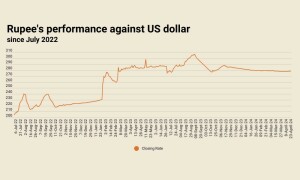Pent-up demand driving global factory revival
• Eurozone factories buzzing amid soaring demand
• Japan manufacturing expands at fastest pace in two years
• China’s private PMI expands at slowest pace in nine months
LONDON/TOKYO: Demand for manufactured goods drove extended growth in factories across Europe and Asia in February, but a slowdown in China underscored the challenges countries face as they seek a sustainable recovery from the COVID-19 pandemic blow.
Restrictions imposed around the world to try and quell the spread of the coronavirus have shuttered vast swathes of the services industry, meaning it has fallen to manufacturers to support economies.
But vaccine rollouts and a pick-up in demand provided optimism for businesses that have grappled for months with a cash-flow crunch and falling profits.
IHS Markit’s final Manufacturing Purchasing Managers’ Index (PMI) jumped to a three-year high of 57.9 in February from January’s 54.8, beating the initial 57.7 “flash” estimate for one of the highest readings in the survey’s 20-year history.
German factory activity also reached a three-year peak last month and in France the pace of growth accelerated. Italy and Spain also saw a pick-up.
However, lockdown measures disrupted supply chains and factories struggled to obtain raw materials, leading to a big increase in delivery times.
Factories in Britain, outside the euro zone and the European Union, reported the slowest output growth since May last month. Disruptions and rising costs linked to Brexit and COVID-19 limited their ability to respond to a modest pick-up in orders.
Manufacturing activity in Japan expanded at the fastest pace in over two years and South Korea’s exports rose for a fourth straight month, suggesting Asia’s export-reliant economies were benefiting from robust global trade.
On the flip side, China’s factory activity grew at the slowest pace in nine months, hit by a domestic flare-up of COVID-19 and soft demand from countries under renewed lock-down measures.
“In all, the softer pace of activity in today’s (Chinese) manufacturing print is likely to be temporary, and we expect the growth momentum to pick back up on the back of a broadening out of the domestic demand recovery and a pick-up in global demand,” said Erin Xin, an economist at HSBC.
China was the first major economy to lead the recovery from the COVID-19 shock, so any signs of prolonged cooling in Asia’s growth engine will likely be a cause for concern.
With the global rebound still in its early days, analysts said the outlook was brightening as companies increased output to restock inventory on hopes vaccine rollouts normalise economic activity.
China’s Caixin/Markit Manufacturing PMI fell to 50.9 in February, the lowest level since last May but still above the 50 mark that separates growth from contraction.
Activity elsewhere in Asia remained brisk.
The Japan PMI jumped to its highest since December 2018. In South Korea, a regional exports bellwether, shipments jumped 9.5% for a fourth straight month of increase.
India’s factory activity expanded for the seventh consecutive month on strong demand and increased output, though a spike in input costs could weigh on corporate profits ahead.
The Philippines, Indonesia and Vietnam also saw manufacturing activity expand in February, a sign the region was recovering from the initial hit of the pandemic.






















Comments
Comments are closed.